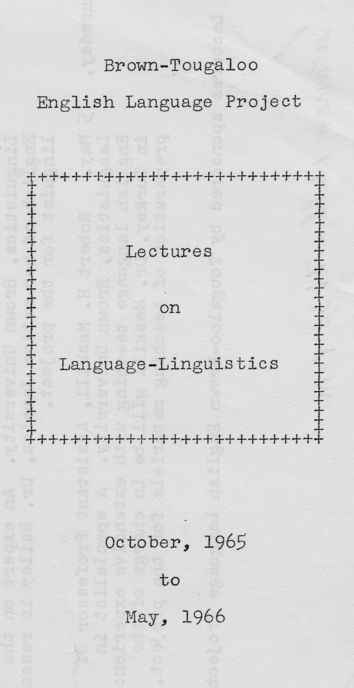Brown-Tougaloo Language Project
A Controversial Experiment
 The establishment of the Brown-Tougaloo Cooperative Exchange brought about a number of projects designed to promote the academic and economic growth of Tougaloo College. One of the most controversial was the Brown-Tougaloo Language Project (BTLP). In December 1964, Brown University submitted a $200,000 grant proposal to the Rockefeller Foundation outlining a program to teach "standard" or "formal" English dialect to recent high school graduates participating in the Pre-Freshman Summer Program at Tougaloo. The Language Project originated from a concern that the dialect of students educated in historically Black universities across the rural South marked them as socially inferior and the products of substandard educations. BTLP sought to give Tougaloo students command of a dual dialect that they could shift in and out of depending on the social situation. Based on scholarly linguistic principles, the BTLP was modeled after widely-used English as a Second Language (ESL) programs with the hope that the new dialect could supplement a student's "native tongue."
The establishment of the Brown-Tougaloo Cooperative Exchange brought about a number of projects designed to promote the academic and economic growth of Tougaloo College. One of the most controversial was the Brown-Tougaloo Language Project (BTLP). In December 1964, Brown University submitted a $200,000 grant proposal to the Rockefeller Foundation outlining a program to teach "standard" or "formal" English dialect to recent high school graduates participating in the Pre-Freshman Summer Program at Tougaloo. The Language Project originated from a concern that the dialect of students educated in historically Black universities across the rural South marked them as socially inferior and the products of substandard educations. BTLP sought to give Tougaloo students command of a dual dialect that they could shift in and out of depending on the social situation. Based on scholarly linguistic principles, the BTLP was modeled after widely-used English as a Second Language (ESL) programs with the hope that the new dialect could supplement a student's "native tongue."
The key players involved in the BTLP saw their job as going beyond merely instructing students in reading and writing. Brown Linguistics Professor W. Nelson Francis worked with Tougaloo English Department Chair Professor Naomi Townsend and Brown Linguistics Department Chair Professor W. Freeman Twaddell to recruit qualified linguists from all over the nation to help guide the program. The program emphasized repetitive oral exercises, and postponed written instruction until after verbal coaching.
The implementation of the BTLP involved a series of phased research and study trials before undertaking a curriculum for Tougaloo pre-freshmen and eventually all of its freshman class. The ultimate goals of the program went beyond simply teaching a new form of English; in 1965, Phase I initiatives attempted to identify a "target dialect" for study by interviewing successful Tougaloo alumni as well as other college-educated Blacks throughout the nation. As a study trial began at Tougaloo in the summer of 1966, the onset of Phase II also marked the initiation of a similar study at Southern University in Baton Rouge, Louisiana. Finally, the start of Phase III in the summer of 1968, allowed for a full-scale trial of the newly developed curriculum and teaching methods throughout the summer and into the academic year. In addition, the BTLP sponsored a series of monthly lectures addressing dialectic linguistic research, all of which indicated that the organizers of the BTLP saw the program as a social science experiment.
Even the organizers of BTLP recognized problems with the program. In a speech associated with the Language Project lecture series, Dr. San-Su Lin, the professor in charge of the other language program funded through the Rockefeller Grant (at Southern University), listed potential complications of such teaching programs. Lin wrote:
Unfortunately, in our eagerness to teach the student standard or 'better' English, we sometimes further complicate the task for ourselves and for him by repudiating, consciously or unconsciously, his dialect, and by implication, repudiating the student himself and antagonizing him. We often forget that even though a student's dialect may be nonstandard, it has great value for him." Student participation in the BTLP was further complicated by their fear of alienating friends and family by a sudden change in their spoken language.
The BTLP met with loud criticism from the African American public, in Jackson and around the country, as well as from Tougaloo professors themselves. Program organizers found themselves spending time defending the BTLP and its underlying scientific rationale.
The end of the 1968-1969 academic year at Tougaloo marked the conclusion of the Brown-Tougaloo Language Project, as funding supported only one year of the curriculum. Despite public disapproval of the project, particularly among African Americans, and poorly articulated and executed program objectives, the documents we examined showed that the organizers were well-intentioned. In addition, by attempting to teach standard English as a second language, the BTLP indirectly validated the dialect of Tougaloo students as a legitimate language. Finally, the BTLP can help us remember the state of race relations and the position of African Americans in 1968 when linguists, headed by Brown faculty, wanted to teach standard English to Tougaloo students.
Related Documents
- Letter, Barnaby Keeney, President, Brown University, to George Harrar, President, Rockefeller Foundation, 18 January 1965
- Press Release, Brown-Tougaloo Language Project, Brown University, 6 September 1968
- Report on Meeting of Tougaloo Remedial Program, Brown University, 17 August 1964
- Lecture Schedule, Brown-Tougaloo Language Project, Tougaloo College, October 1965 to May 1966
- Memo, R.H. Meskill to W. N. Francis, Brown University, 8 October 1968